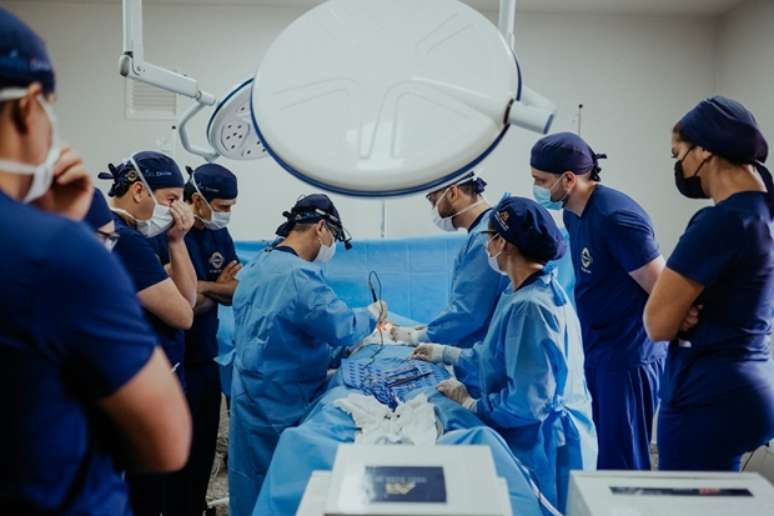The scar is one of the concerns of women who undergo plastic surgery. In the case of breast surgery, the question most often revolves around wearing low-cut clothing and whether the procedure will leave any visible marks.
The scar is one of the concerns of women who undergo plastic surgery. In the case of breast surgery, the question most often revolves around wearing low-cut clothing and whether the procedure will leave any visible marks. thinking about it, a mastopexy technique – surgery that aims to lift and reshape the breasts – with reduced scarring in L it is already considered the preference among the female audience.
The L-shaped scar is made with an incision around the areola, a small vertical cut and an approximately 4 cm horizontal incision on the underside of the breast. The absence of a scar between the breasts does not increase the lateral horizontal scar, improves the shape of the inside of the breast and allows women to choose their own clothes without worrying about the brand.
The entrepreneur who works in the financial market, Eliane Miranda da Costa, 43, took 15 years to perform the much-dreamed-of breast operation, precisely because of the fear of the scar.
“All the doctors said that because of my breast sagging, it should be a T-shaped scar, which would leave marks on both sides of the breast. That’s when I discovered L-shaped mastopexy and realized that could reduce the cuts and marks,” he says. .
According to her, the operation changed her life. “Before I couldn’t wear a backless dress because I had to wear a bra, I couldn’t wear a strapless dress because my breasts literally fell off. Today my self-esteem has improved a lot and every time I can wear low cuts,” she says.
Brazil is the second country in the world in terms of plastic surgery, with 1.3 million procedures performed annually. Mastopexy surgeries also appear in second place, according to the latest survey conducted by the Brazilian Society of Plastic Surgery (2020).
Unprecedented systematization of the technique
The multi-plane mastopexy technique with L-shaped scar – was systematized for the first time in Brazil by the Paraná surgeon, Adel Bark Junior, with one big difference: it acts individually on the three anatomical components of the breast: that is why it is called multi-plane.
In multiplanar mastopexy the surgeon is able to treat the skin, muscle and gland separately. “With the Multiplanos technique we treat the breast internally and symmetrically, improving the internal and external anatomy of each sphere. In this way it is possible to offer a more predictable result and greater stability for the breast in the long term”, explains the surgeon. Furthermore, according to him, multi-planes can raise the inframammary fold (position of the breast in the chest), promoting greater stability, a larger breast neck with smaller implants and lengthening the abdominal region.
The surgeon brings in his curriculum more than three thousand mastopexy operations using the L-shaped scar, currently the method he uses in 100% of patients. The high level of satisfaction of the operated patients, due to a smaller incision, led the surgeon to dedicate himself to the reproduction of the technique, which is an evolution of the incision traditionally performed in the shape of an inverted T. As a result, the Multiplanar Mastopexy Course was launched in Curitiba in L.
The L-shaped mastopexy was described for the first time by the surgeon Hollander, in 1924, and subsequently replicated by Brazilian surgeons in the 1980s, with Antonio Roberto Bozola, and in the 1990s, by Chiari Junior, but for many decades it remained little performed, according to Adel Bark Júnior “because of the difficulty of preoperative marking and the limitation of the treatment of the inner part of the breast, since it does not locate the skin and breast tissue”. With the systematization of L-shaped multi-level mastopexy, more than 150 surgeons from Brazil and 9 other countries have already been trained in Curitiba and are applying the concepts to their patients. “Even in voluminous breasts and with great ptosis (sagging), it is possible, with the multiplanar technique, “to deliver stability and a reduced L-shaped scar,” says the Curitiba surgeon.
Differential
Adel says he has gradually eliminated the need for preventive appointments, which generated great surgical complexity, and has applied the technique to increasingly difficult cases. “By eliminating the previous marking, we have managed to systematize a reproducible way of performing the L-shaped scar technique, such that the vast majority of surgeons who have come to learn how to replicate it are performing the L-shaped scar on their patients; several colleagues report that even when they are unable to deliver the L-shaped scar, the multi-plane concept has allowed them to reduce their scarring and promote greater surgical stability,” she points out.
“Today, we are fulfilling our role of benefiting as many women as possible through the hands of our colleagues, enabling them to perform the procedure safely. With our online teaching platform, we integrate and consolidate shared concepts into the hands-on course,” says Adele.
Website: http://dradelbarkjr.com.br/
Source: Terra
Rose James is a Gossipify movie and series reviewer known for her in-depth analysis and unique perspective on the latest releases. With a background in film studies, she provides engaging and informative reviews, and keeps readers up to date with industry trends and emerging talents.


-qhia6ba319wh.png)




